Related Research Articles
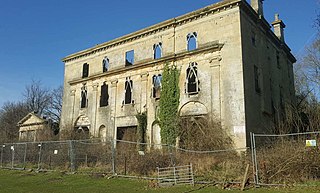
Piercefield House is a largely ruined neo-classical country house near St Arvans, Monmouthshire, Wales, about 1.5 miles (2.4 km) north of the centre of Chepstow. The central block of the house was designed in the very late 18th century, by, or to the designs of, Sir John Soane. It is flanked by two pavilions, of slightly later date, by Joseph Bonomi the Elder. The house sits within Piercefield Park, a Grade I listed historic landscape, that was created in the 18th century as a notable Picturesque estate.
Kilgetty is a village immediately north of Saundersfoot in Pembrokeshire, Wales, at the junction of the A477 between St. Clears and Pembroke Dock and the A478 between Tenby and Cardigan.

Penally is a coastal village, parish and community 1 mile (1.6 km) southwest of Tenby in Pembrokeshire, Wales. The village is known for its Celtic Cross, Penally Abbey, the neighbouring St. Deiniol's Well, WWI Practice trenches, and Penally Training Camp.

Bedwellty House is a Grade II-listed house and gardens in Tredegar, in the Sirhowy Valley in south-east Wales. It was built in the early 19th century on the site of an earlier building and subsequently enlarged into its present form by mid-century. The owners donated the house and its grounds to the public at the beginning of the 20th century. They were restored at the beginning of the 21st century. The grounds are included on the Cadw/ICOMOS Register of Parks and Gardens of Special Historic Interest in Wales, the only estate so listed in Blaenau Gwent.
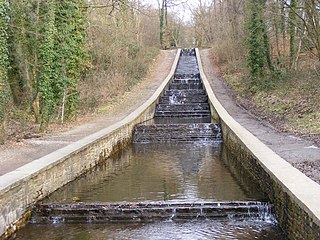
The Gnoll Country Park is a park in Wales. It is an early-18th-century landscaped garden covering over 100 acres (0.40 km2) in the Vale of Neath, in Neath Port Talbot county borough in south Wales. The park is designated Grade II* on the Cadw/ICOMOS Register of Parks and Gardens of Special Historic Interest in Wales.

Jeffreyston is a village, parish and community in Pembrokeshire.

Warren is an ancient parish in the community of Stackpole and Castlemartin, in the most southerly part of Pembrokeshire, Wales. Its northern edge is 5 miles (8 km) south of Pembroke and its southern edge reaches the sea at Flimston Bay. It is bordered by Castlemartin to the west, St Twynnells to the east and Monkton to the north.
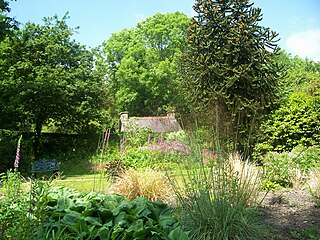
Colby Woodland Garden is a National Trust woodland garden in a secluded valley, approximately ¾ of a mile north of Amroth in Pembrokeshire, Wales. It is listed on the Cadw/ICOMOS Register of Parks and Gardens of Special Historic Interest in Wales.
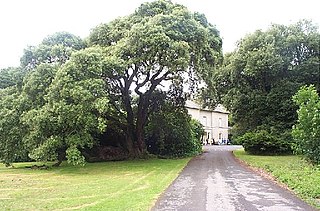
Scolton Manor is a Victorian country house and country park located in Pembrokeshire, West Wales northeast of Haverfordwest and on the borders of the Pembrokeshire Coast National Park. Built as a home, it is now a museum and is a Grade II* listed building. The stable court, some 120 m (130 yd) to the north, is also a Grade II listed building and both are owned by Pembrokeshire County Council. The gardens and parkland are listed on the Cadw/ICOMOS Register of Parks and Gardens of Special Historic Interest in Wales. The house, grounds and a number of exhibits are open to the public.

Great Western Mine, also known as Hetty Pit, was a coal mine, at Hopkinstown, near Pontypridd, Glamorgan in South Wales.

This is a list of the 187 Grade II*-listed buildings in the county of Pembrokeshire, Wales.

St Justinian is a coastal location of indeterminate area in the extreme northwest of Pembrokeshire, Wales, in the community of St Davids and the Cathedral Close.

Ye Olde Murenger House is a 19th-century pub with a mock Tudor front on High Street, Newport, Wales. It replaced a 17th-century pub, the Fleur de Lys, on the same site. It is named after the medieval job of a murenger, a person who collected tolls for the repair of the town walls, and is Grade II listed due to its historic interest to the immediate area.
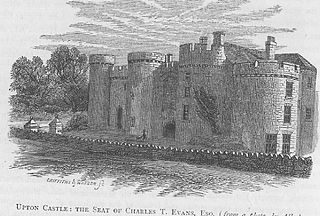
Upton Castle is a 13th-century castle or fortified manor house with an associated chapel, located near Cosheston, Pembrokeshire in Wales. Although in private ownership, the gardens are open to the public. They are listed on the Cadw/ICOMOS Register of Parks and Gardens of Special Historic Interest in Wales.

Ffynone is a mansion and estate near Boncath, Pembrokeshire, Wales, in the parish of Manordeifi. The original Georgian design was by the architect John Nash, and the house was later remodelled by Inigo Thomas. It is a Grade I listed building, and its gardens and park are also listed, at Grade I, on the Cadw/ICOMOS Register of Parks and Gardens of Special Historic Interest in Wales.

Orielton is a historic country house near Hundleton in Pembrokeshire, Wales. It has been used as a field studies centre for environmental sciences but was put on sale in early 2022.
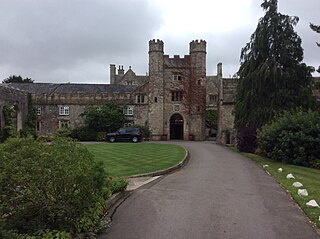
The Gatehouse and attached range, at the St Pierre Hotel, St Pierre, Mathern, Monmouthshire are the most significant remains of the mansion built by the Lewis family in the late 15th century and owned by them until 1924. The original house was built by William Lewis, and extended by his son George, between 1475 and 1508. After the Lewises sold up, the house had a variety of owners and was converted to the clubhouse of a golf club in 1962. It has since been massively extended as a hotel and country club. The gatehouse and range have Grade II* listed building status. The surrounding gardens are included on the Cadw/ICOMOS Register of Parks and Gardens of Special Historic Interest in Wales.

St Brides Castle is a 19th-century castellated baronial-style mansion in the parish of St Brides and the community of Marloes and St Brides, Pembrokeshire, southwest Wales.

Pembrokeshire is a county in the south-west of Wales. It covers an area of 1,619 km2 (625 sq mi). In 2021 the population was approximately 123,700.

Navigation Colliery is a former coal mine in Crumlin, Caerphilly County Borough, Wales. Opened in 1911, at its peak it produced 145,000 tonnes of coal a year. The mine closed in 1967 and the site has been disused since. The Royal Commission on the Ancient and Historical Monuments of Wales (RCAHMW) considers the Navigation site to be "the best preserved colliery complex in South Wales". The complex contains thirteen listed buildings, five at Grade II*, the rest at Grade II. The site is now managed by a charitable trust, Glofa Navigation Cyf, which seeks to redevelop it for community benefit.
References
- ↑ Cadw. "Cresselly House (Grade II*) (15933)". National Historic Assets of Wales. Retrieved 14 February 2023.
- ↑ Cadw. "Cresselly (PGW(Dy)31(PEM))". National Historic Assets of Wales. Retrieved 6 February 2023.
- ↑ "A PEMBROKESHIRE COUNTY FAMILY IN THE EIGHTEENTH CENTURY". Genuki. Retrieved 12 July 2013.
- ↑ "(Allen) Family History". Archived from the original on 5 September 2013. Retrieved 12 July 2013.
- ↑ "Cresselly". Archived from the original on 3 March 2016. Retrieved 12 July 2013.